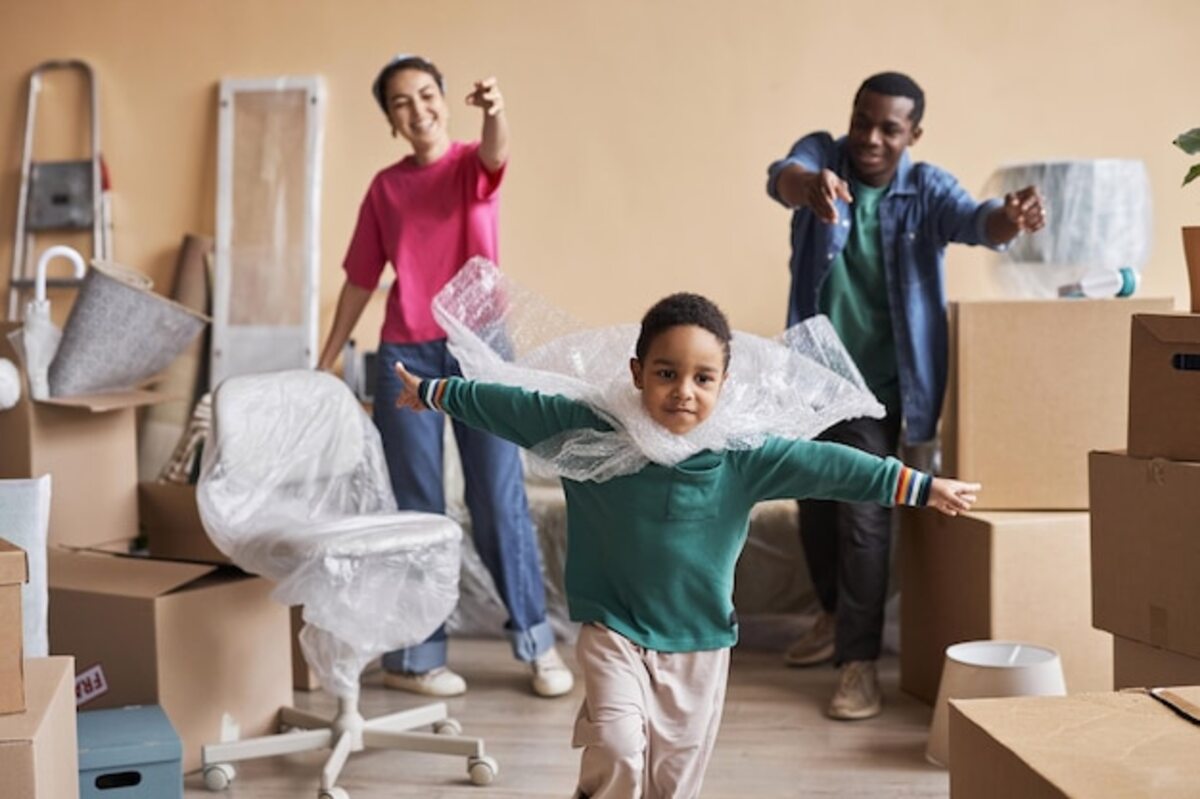How to involve the whole family in the moving process

Involving the whole family in the moving process not only facilitates logistics but also transforms this experience into a shared adventure. From the youngest to the adults, each member can contribute their part, making the transition smoother and less stressful. In this article, we will explore how to integrate everyone in this crucial stage, highlighting the importance of a good transportation service and effective strategies to make the move a memorable moment.
The importance of planning together
Joint planning is essential for the whole family to feel involved and committed during the moving process. From the very beginning, it is crucial to sit down with all family members and discuss the details of the move: from choosing the new house to deciding which furniture and belongings to take. This approach not only helps to better organize tasks but also allows each person to express their opinions and wishes, creating a sense of belonging to the new home. By listening to everyone's ideas and concerns, more informed decisions can be made that benefit the entire family.
Additionally, planning together fosters a sense of teamwork and collaboration. When each member assumes a specific role in the process—whether it's packing boxes, sorting items, or even decorating the new space—a more positive and cooperative atmosphere is created. This shared experience can become a great opportunity to strengthen family bonds; by working together to solve problems or overcome obstacles, lasting memories are created that transcend the simple act of moving. Thus, collective planning not only facilitates the logistics of the move but also transforms this challenge into an exciting adventure for everyone.
2. Assign tasks according to ages and skills.
Assigning tasks according to the ages and abilities of each family member is essential for everyone to feel involved and useful during the moving process. Children, for example, can take care of packing their toys, clothes, and books in boxes that they decorate with drawings or colorful labels. This type of activity not only gives them a sense of responsibility but also helps them process the transition to the new home. For teenagers, more complex tasks can be assigned, such as dismantling smaller furniture or helping organize the space in their new room, allowing them to feel like an active part of the change.
On the other hand, adults can focus on the heavier logistical tasks, such as coordinating transportation services, conducting inventory of items, and overseeing the overall packing. By dividing responsibilities according to individual capabilities, a collaborative environment is fostered where each person contributes to the success of the process. Furthermore, this provides an opportunity to strengthen family ties while working together towards a common goal: establishing a new home filled with shared memories.
3. How to choose the best family transportation service
Choosing the best family moving service is a crucial step in the moving process. To ensure that the experience is as smooth as possible, it is important to research and compare various options available in the market. Start by identifying companies that specialize in family moves, as they tend to have more experience handling the specific needs of households. Read reviews and testimonials from other customers to gauge their level of satisfaction and reliability. Additionally, do not hesitate to ask for recommendations from friends or family members who have recently moved; their experience can be invaluable.
Once the options are narrowed down, evaluate each service based on key aspects such as prices, insurance offered, and equipment availability. Be sure to discuss important details like flexible schedules and the ability to transport delicate or bulky belongings. It is also advisable to request detailed quotes to avoid surprises at the end of the process. Remember that the best service is not always the cheapest; the quality of service and customer care are equally important to ensure a smooth move with all family members involved in this exciting stage.
4. Creating a moving activities calendar
Creating a moving activity calendar is an excellent way to keep the whole family organized and engaged in the process. By setting specific dates for each task, from packing to the final cleaning in the previous home, you can assign responsibilities to each family member based on their age and abilities. For example, children can take care of packing their toys, while adults handle more complex areas like the kitchen and furniture. This approach not only facilitates logistics but also teaches the younger ones about planning and teamwork.
Additionally, a visual calendar can be a motivating tool for everyone. Placing a large poster in a visible spot in the house with the scheduled activities can generate excitement and anticipation for the move. Each time a task is completed, a small family celebration can be held or it can be marked as done; this reinforces the sense of collective achievement. With a well-structured calendar, each family member will not only be aware of the progress but will also see how their contribution is valuable to the success of the change, thus transforming what could be a stressful process into an enriching experience filled with shared memories.
5. Fun ideas to engage children in the process
One of the most effective ways to engage children in the moving process is to turn it into a game. You can organize a "treasure hunt" where each child has to find and pack certain items, like their favorite toys or books. This not only allows them to feel that they are contributing to the move, but also helps them become familiar with their new home by searching for specific items that they can then place in their new room. Additionally, you can create a reward system, where each time they complete a task they receive a small prize, which will make them feel motivated and excited to participate.
Another fun idea is to create a moving journal. Provide your children with notebooks or decorated sheets where they can draw or write about their experiences during the process. They can document how they feel about the move, what they expect from the new place, and even include photos of funny moments while packing or traveling to their new home. In the end, this journal will not only serve as a special keepsake of this stage, but it will also help them process their emotions and create positive expectations about their new family adventure.
6. Tips for staying calm during the move
Staying calm during the move is essential for the whole family to feel comfortable and positive about the relocation. It's natural for nerves and stress to arise during times of change, but establishing a calm atmosphere can make a difference. A good strategy is to plan ahead and divide tasks among family members, which not only lightens the load but also allows each person to have a sense of control over the process. Be sure to schedule regular breaks and moments of fun, such as games or small celebrations between activities, to relieve tension and strengthen family bonds.
Additionally, it is essential to maintain open communication throughout the process. Encourage each family member to express their feelings about the move; this can include concerns or expectations about their new home. Actively listening and validating those emotions will help everyone feel more connected and supported. You can also create a "to-do" list where each person can mark their achievements, thereby creating a sense of collective accomplishment that will make them feel like they are working together toward a common goal: making the new home a special place for everyone.
7. Preparing the new home: a family task
Preparing the new home is a crucial stage in the moving process, and involving the whole family can make this task more manageable and enjoyable. From choosing the colors of the walls to deciding the layout of the furniture, each member can contribute their ideas and preferences. This not only fosters a sense of belonging in the new space but also helps everyone feel part of the change. Organizing group activities, such as a day to decorate or unpack together, can transform what could be a stressful moment into a collaborative experience full of laughter and memories.
Involving children in the preparation of the new home gives them the opportunity to express their creativity and emotions about the change. Assigning them specific tasks, such as choosing where to place their toys or helping to organize their room, helps them adapt more easily to the new environment. Similarly, adults can share responsibilities when planning the necessary purchases for the home, thus creating a strong team where each person has their important role. At the end of the day, preparing the new home together will not only facilitate the logistics of the move but also strengthen family bonds while building a space that reflects who they are as a unit.
8. Celebrating the arrival: get everyone involved in the decoration
Celebrating the arrival at a new home is an excellent opportunity for all family members to actively participate in the decoration. This activity will not only allow them to express their creativity, but it will also foster a sense of belonging from the very first moment. You can organize an afternoon of crafts where everyone chooses a space they would like to decorate: whether it's their room, the living room, or even the garden. Providing materials such as paints, pencils, and recycled decorations can inspire the little ones to get involved and unleash their imagination, turning what could be a tedious task into a fun family project.
Additionally, creating a collaborative atmosphere during this phase will help strengthen family bonds. Consider assigning different roles to each member according to their interests; for example, one can take charge of choosing colors while another focuses on hanging pictures or decorations. Holding brainstorming sessions to discuss ideas on how to incorporate family memories or elements with personal significance into the decor can make every corner of the new home tell a unique story. At the end of the day, seeing together how the space transforms, everyone will feel that they have left their mark on this new chapter of life.
9. Reflecting on the experience: what was learned as a family
Reflecting on the experience of a family move can be an invaluable opportunity to strengthen bonds and learn important lessons. At the end of the process, it is advisable to take some time to talk about what each member experienced during the move. What did they enjoy the most? What were the difficult moments and how did they overcome them together? These reflections not only help process the experience, but also foster a sense of unity and collaboration at home, creating memories that last beyond the physical change of residence.
Additionally, when evaluating what has been learned as a family, areas for improvement can be identified for future moves or joint projects. It may be discovered that some members are excellent organizers and could take on similar roles in the future. This feedback allows each person to feel valued for their unique contributions, strengthening their self-esteem and sense of belonging. Ultimately, taking time to reflect on the moving experience not only closes a chapter but also opens the doors to new family adventures with greater cohesion and mutual understanding.



